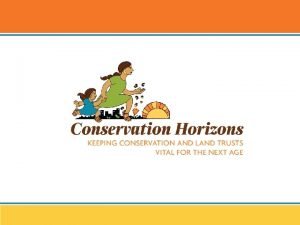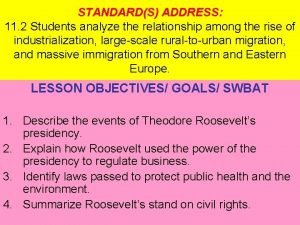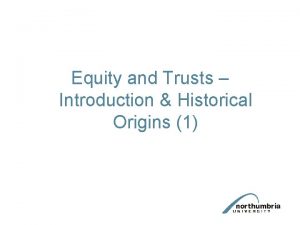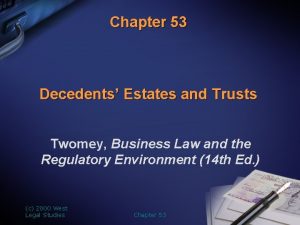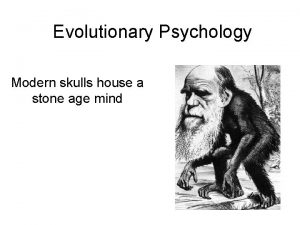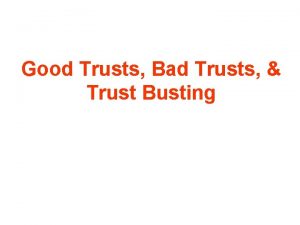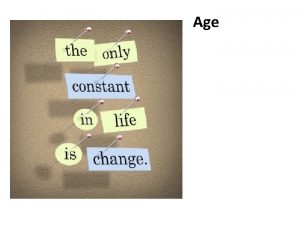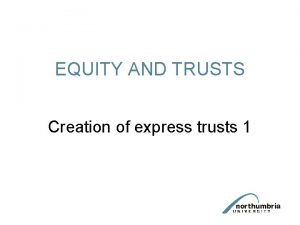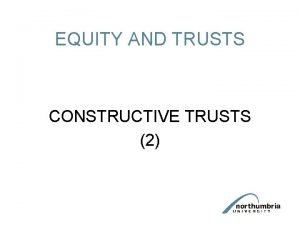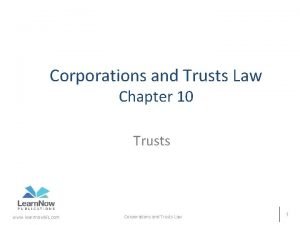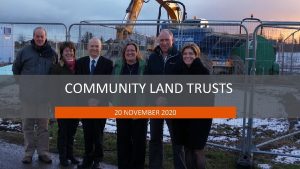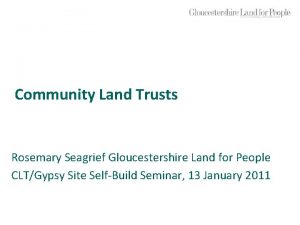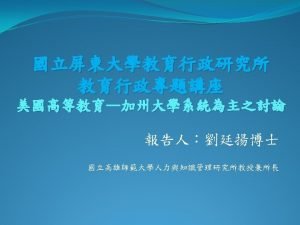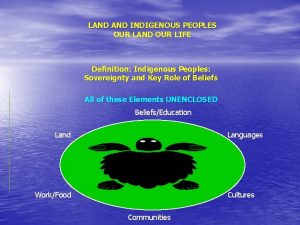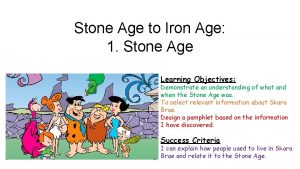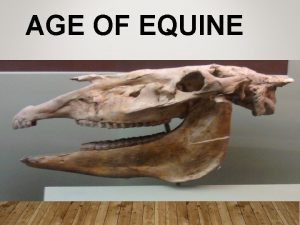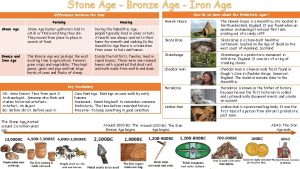CALIFORNIA LAND TRUSTS OUR FIRST AGE Land trusts































- Slides: 31


CALIFORNIA LAND TRUSTS – OUR FIRST AGE Land trusts conserved over 1. 7 million acres in California

CONSERVATION HORIZONS Over the past several years, indicators of changing times have figured increasingly in land trust conversations. Concerns include: • • Organizational sustainability Leadership transitions Age & diversity of supporters Board recruitment and engagement Stewardship challenges Funding constraints Climate change impacts Unclear how to respond. Issues seem beyond individual land trust.

HORIZONS COMMITTEE Who? Diverse group of land trust leaders, conservation funders, other partners When? CCLT formed Committee Summer 2014 Purpose? Frame and support a statewide discussion about the next age of land conservation—between now and 2050. • • identify facts and trends paint a picture of future devise strategies address challenges & opportunities proactively

DESIRED OUTCOME Ensure the continued vitality of land trusts and partner institutions, and protected lands by making conservation relevant to, and valued by, all Californians. (Will mean changes to organizations and types of conservation projects. )

THE FIRST STEP Data inundation – hard to single out most important, relevant to and comprehensive for land conservation. Committee poured through data – identified facts and trends key to land trust future through 2050. Organized into five key topic areas: • Population • Culture and Attitudes • Land Resource Trends • Funding • Land Trusts

FACTS & TRENDS SHEETS Data on Facts & Trends sheets drawn from variety of sources We identify a few items from each sheet. We want your thoughts and ideas about what all this means for the future of land trusts & conservation in California. To get you started, we offer a few “directional observations” from the facts and trends.

POPULATION Non-white and Latino majorities In March, Latinos surpassed whites as the largest majority of the population in California, at 39%. • • Latinos, Asians growing by double digits African Americans, Caucasians remain close to static Over half of children are Latino 43% of all residents speak language other than English at home

POPULATION, cont. We will be older, heavier and poorer. • Nearly a quarter of us will be over 65 • Nearly half of will be obese • A quarter or more of us will live in poverty

POPULATION, cont. • CA will add another metropolitan LA, concentrated in 12 southern and so Central Valley counties • 95% already live in urban areas & urban clusters

CULTURE AND ATTITUDES People use and interact with outdoor areas differently. • • Whites prefer passive uses, like hiking Latinos use parks for multi-generational social gatherings African Americans use parks for active recreation Asians have low levels of park use

CULTURE AND ATTITUDES, cont. Unequal access to parks: • Poorer areas have fewer parks • Poorer residents have less mobility an disposable income to reach the few that do exist Large numbers of children cite lack of interest as the top reason they spend less time outdoors.

CULTURE AND ATTITUDES, cont. Millennials are the dominant parents, funders, voters in our future. • • • currently 14 -35 yrs old larger numbers than Baby Boomers greater spending power will decide next 6 presidential elections optimistic technologically savvy less religious racially diverse color-blind In 2050, Millennials will be 50 -70 years old

LAND & RESOURCES Climate Change Impacts “bigger” and “worse” • Fires more frequent and severe • Water quality will worsen in the aftermath of fires • Water supply will swing wildly due

LAND & RESOURCES, cont. • Coastal and inland storms increase in frequency and severity resulting in erosion and flooding • Habitat losses will continue • Farm and grazing land losses will continue to increase

FUNDING Since 2000, $15 billion voter-approved funds • growth of land trusts, agencies • 1. 5 million acres conserved • created huge stewardship challenge Conservation support may change as younger generations have different concerns/priorities as is revealed in their choice of activities, giving & voting

FUNDING, cont.

LAND TRUSTS LTs hold over 1. 7 million acres in fee and easement • more acres given to public land base LT acquisitions = important change in last generation Protected lands not where people live

LAND TRUSTS, cont. Small number of land trusts hold majority of fee lands and conservation easements

LAND TRUSTS, cont. Generally, LT leadership does not look like California

REFLECTION POINT As a community, we are at a reflection point. We are compelled to ask and answer: 1. What additional lands do we need to acquire? 2. How do we take care of our conserved lands? 3. What will we do on our conserved lands? 4. How will our institutions deliver the necessary solutions?

YOUR HELP NEEDED This is what we want your engagement and help in tackling. These are the questions we want you to consider. We offer several observations about directions Facts & Trends point us in. Some… • apply to the individual organizational level • others apply at the industry level in California • some have implications for both

DIRECTIONAL OBSERVATIONS We are not connecting with many Californians… especially in urban and underserved communities. Questions: • What types of projects are we doing? • Who does our choice of projects serve? • How do we make conservation relevant to the underserved, the unrecognized, whether they live in Shasta, Plumas, Napa or Los Angeles counties?

DIRECTIONAL OBSERVATIONS, cont. Involving and engaging the Latino population • Latinos increasingly in leadership positions to drive policy outcomes • While supporting past bond measures, relatively small level funding went to Latino communities or for preferred types of projects. • Organizations like Amigos de los Rios, Big Sur Land Trust, Los Angeles Neighborhood Land Trust, Trust for Public Land have directly engaged the Latino population. • Generally, we have a long way to go to directly involve Latinos and support their conservation leadership.

DIRECTIONAL OBSERVATIONS, cont. Millennials will figure prominently in our future. • Millennials have great buying and political power. • They are going to shape California in the next 40 years in huge ways. • Only 4% of Millennials rank environment as a top cause. • This is a demographic to whose lives we must find ways to make conservation relevant.

DIRECTIONAL OBSERVATIONS, cont. Climate change causing many pressing public problems. How will protecting land compete against: • massive droughts • extreme, frequent fires • large scale flooding • infrastructure collapse • skyrocketing public health problems due to extreme heat and terrible air quality? Land conservation has a substantive contribution to make to these problems, but we must be prepared to “prove up” and relate our work to broader priorities.

DIRECTIONAL OBSERVATIONS, cont. Achieving meaningful stewardship • How are we going to crack the stewardship nut? • Business plan to fund stewardship – not just keep fences up? • Will we consider California’s entire conservation portfolio – all protected lands – regardless of ownership? • Before breaking even, we have: • 1. 2 billion in deferred maintenance at state parks • decades of dangerously overgrown federal forest lands • unknown acres of neglected urban parks

DIRECTIONAL OBSERVATIONS, cont. Land trusts will need to make changes Organizational make-up? Our future effectiveness will require us to have boards and staffs that reflect the ethnicities, gender, and ages of the communities we serve. Communications? We must find better ways to measure our impacts and communicate our results to broader audiences. Get beyond “bucks and acres” Project Types? • different projects – local parks, community gardens • programming – education, jobs

DIRECTIONAL OBSERVATIONS, cont. What is conservation job ahead of us? In our first age, the defining characteristic of land trusts has been to acquire land to hold/flip it. As we look forward, the job appears bigger than this. • What skills, capacities, partnerships do LTs need? • How do we build and industry capable of sustaining protected lands and building broader community support? • What kinds of projects are most relevant and meaningful to urban and underserved Californians?

LTS HAVE DONE REMARKABLE JOB California is changing. As we look forward, will we not change and become irrelevant, obsolete? Or, will we expand conservation’s relevance to all Californians?

THANK YOU Please share your ideas, comments, concerns and questions. www. calandtrusts. org/conservationhorizons
 California land trusts
California land trusts Iron age bronze age stone age timeline
Iron age bronze age stone age timeline Iron age bronze age stone age timeline
Iron age bronze age stone age timeline What steps did roosevelt take to solve trusts
What steps did roosevelt take to solve trusts The vulture's roost political cartoon meaning
The vulture's roost political cartoon meaning During the late 1800s the defenders of social darwinism
During the late 1800s the defenders of social darwinism Industrialists of the late 1800s used pools and trusts to
Industrialists of the late 1800s used pools and trusts to Content filtering trusts
Content filtering trusts Special needs trusts colorado
Special needs trusts colorado Parshvanath charitable trusts a.p.shah inst.of tech
Parshvanath charitable trusts a.p.shah inst.of tech History of equity and trusts
History of equity and trusts Mussett v bingle 1876
Mussett v bingle 1876 Equity and trusts problem question answers
Equity and trusts problem question answers Development trusts ni
Development trusts ni 53 trusts
53 trusts Oil sands extraction process diagram
Oil sands extraction process diagram Trust fund meaning
Trust fund meaning Thinking language and intelligence
Thinking language and intelligence Our census our future
Our census our future Christ, be our light
Christ, be our light Marcus aurelius our life is what our thoughts make it
Marcus aurelius our life is what our thoughts make it We bow our hearts we bend our knees
We bow our hearts we bend our knees Our census our future
Our census our future Our life is what our thoughts make it
Our life is what our thoughts make it Summary of poem money madness
Summary of poem money madness Our awareness of ourselves and our environment
Our awareness of ourselves and our environment Is our awareness of ourselves and our environment.
Is our awareness of ourselves and our environment. God our father christ our brother
God our father christ our brother Our future is in our hands quotes
Our future is in our hands quotes Awareness of ourselves and our environment
Awareness of ourselves and our environment Is our awareness of ourselves and our environment.
Is our awareness of ourselves and our environment. Our modern skulls house a stone age mind
Our modern skulls house a stone age mind
